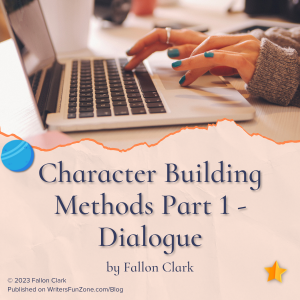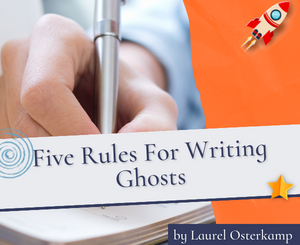Character Building Methods Part 1 – Dialogue by Fallon Clark
 Today we welcome a new guest writer to Writer’s Fun Zone, Fallon Clark who is stopping by to chat with us about “Character Building Methods Part 1 – Dialogue.” Enjoy!
Today we welcome a new guest writer to Writer’s Fun Zone, Fallon Clark who is stopping by to chat with us about “Character Building Methods Part 1 – Dialogue.” Enjoy!
***
Fiction novels have such immense power to take us on wonderful, whimsical adventures, to immerse us in new and exciting worlds, to broaden our horizons and shape our points of view, even make us express big emotions, like fear, grief, and unhinged delight.
Good fiction even has the power to test and either confirm or change our values, beliefs, and purposes.
The source of fiction’s power?
The characters.
While our favorite fictional characters aren’t real people, they feel real to us, serving as temporary friends or family packed into 350 pages we read over a few hours.
And while you may know that a well-formed protagonist must have a want, a related goal, and an underlying need, there are many ways to punch up your protagonist and your other characters to really nail that emotional connection for your readers.
So, how can you craft the kinds of characters readers may bond with, possibly even remember, long after the final page?
There are six methods to craft characters with whom readers may bond. This newsletter issue covers the first method: Dialogue.
Dialogue
Dialogue helps characterize in ways that differ from physical appearance because of the way speech helps translate internal thoughts and ideas into external communications.
But dialogue doesn’t just refer to the speech indicated by quotation marks.
The word “dialogue” used in this context refers to summary, indirect speech, and direct dialogue. Let’s unpack.
Summary
Summary speech is implied speech, the kind of dialogue that is routine, has the potential to bore readers, or covers off-topic information so your readers can get on with the story. Summary allows a chunk of conversation to be condensed and passed over.
Readers don’t need to hear the small talk that starts most phone conversations, don’t need the details of the anniversary gift, don’t even need to hear that funny story.
Instead, readers need to see the relationship between Clark and his mother to gain an understanding of Clark’s priorities, which the summary allows for quickly and efficiently.
Indirect Speech
Indirect speech is more conversational than summary and less so than direct dialogue.
It provides the feel of a verbal exchange without actual quotation marks, and this approach to conversational exchange works well to move readers quickly from information to the possibility of discovery or decision.
Readers encounter this indirect speech as Werner remembers the morning he left the orphanage after having been recruited for military action.
And while gushing can be nice to hear, it doesn’t work well in fiction unless essential to character authenticity development.
In fact, it’s not until a moment of gravity is needed a bit later that quotation marks are used and readers get some understanding of the circumstances under which Werner was recruited.
Direct Dialogue
Direct dialogue is just that –direct speech spoken by a character and offset with quotation marks.
But dialogue in fiction is never used simply to communicate information.
Rather, direct dialogue communicates structured emotion.
That is, the delivery of information and characterization, exposition, setting, advancing action, foreshadowing, or reminding.
In short, fiction dialogue must do two things at once.
Here, the direct speech is used to convey culturally ingrained racism against the Karhiders, as the guard remarks about the man he believes to be dead.
The use of direct dialogue, while conveying information, also provides characterization of both the guard (racist) and the Karhiders and provides information about the setting to build the world for readers.
Using Dialogue to Build Character
Allow yourself to sit for a moment with your character in mind so you can see your character clearly.
Put yourself inside the character, to feel what they feel, to hear the thoughts that may go through their mind at a particular moment in your story.
Which style of dialogue may work best to convey the character’s thoughts, feelings, or message for your scene? Why?
Check in next month for the second method to craft characters with whom readers may bond: Appearance.
Recommended Reads:
Interested in craft books to level-up your writing? Here are three books I most often recommend to new authors.
- Writing Fiction by Janet Burroway
- Self-Editing for Fiction Writers by Renni Browne and Dave King
- The Elements of Style by William Strunk Jr. and E.B. White
Happy writing and editing!
♥ Fallon
***
ABOUT THE AUTHOR
 Fallon Clark is an independent story development coach and editor serving fiction and creative non-fiction authors. Her fiction has been published in Flash Fiction Magazine. When not editing or writing, you will find her gardening, reading tarot, or staring into the universe’s star-crusted abyss to wonder, “What if?”
Fallon Clark is an independent story development coach and editor serving fiction and creative non-fiction authors. Her fiction has been published in Flash Fiction Magazine. When not editing or writing, you will find her gardening, reading tarot, or staring into the universe’s star-crusted abyss to wonder, “What if?”
CONNECT WITH FALLON:
Web: https://www.fallonedits.com
LinkedIn: https://www.linkedin.com/in/fallonedits
Quora: https://www.quora.com/profile/FallonEdits
Minds: https://www.minds.com/itsmefal










Thanks for your post, Fallow!